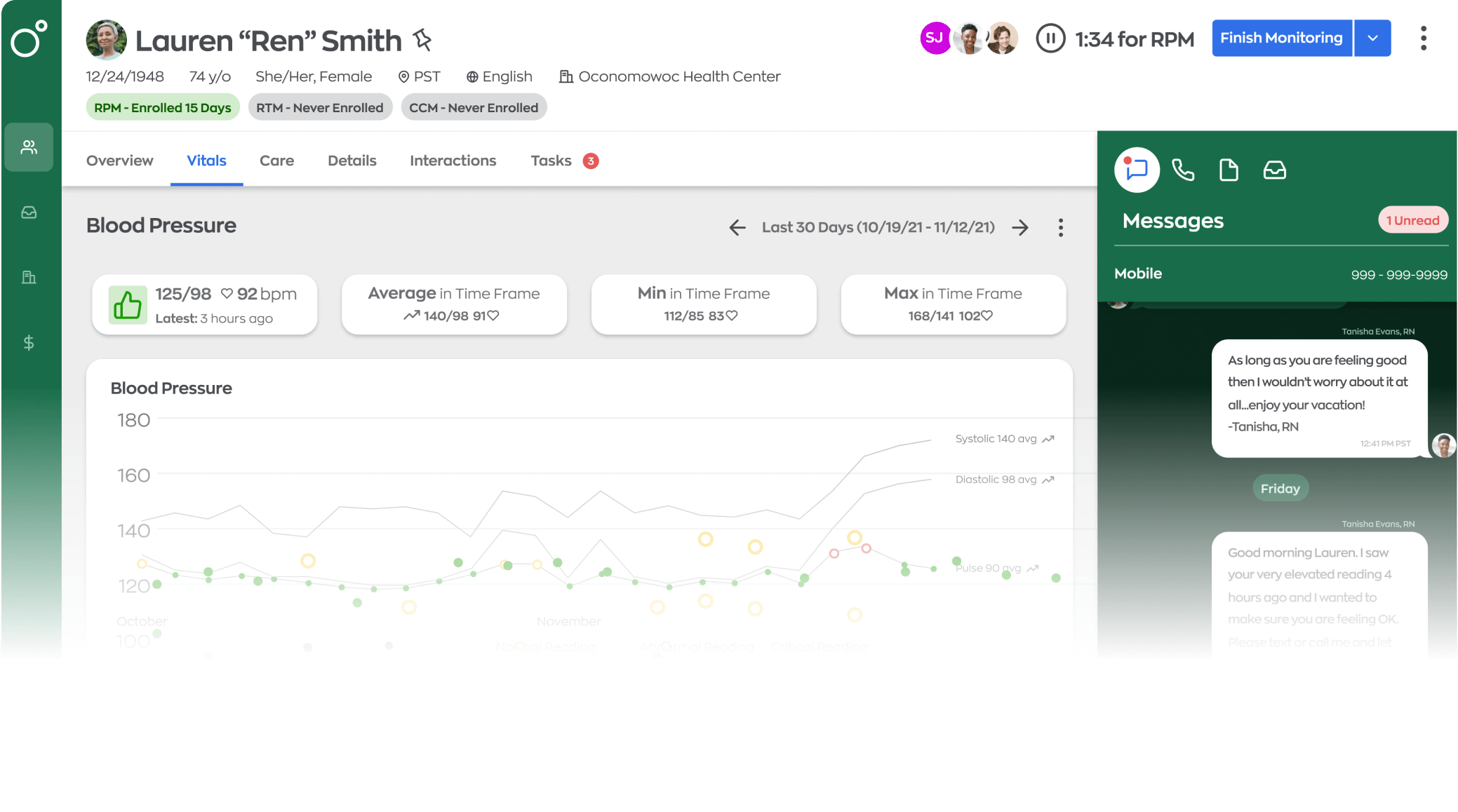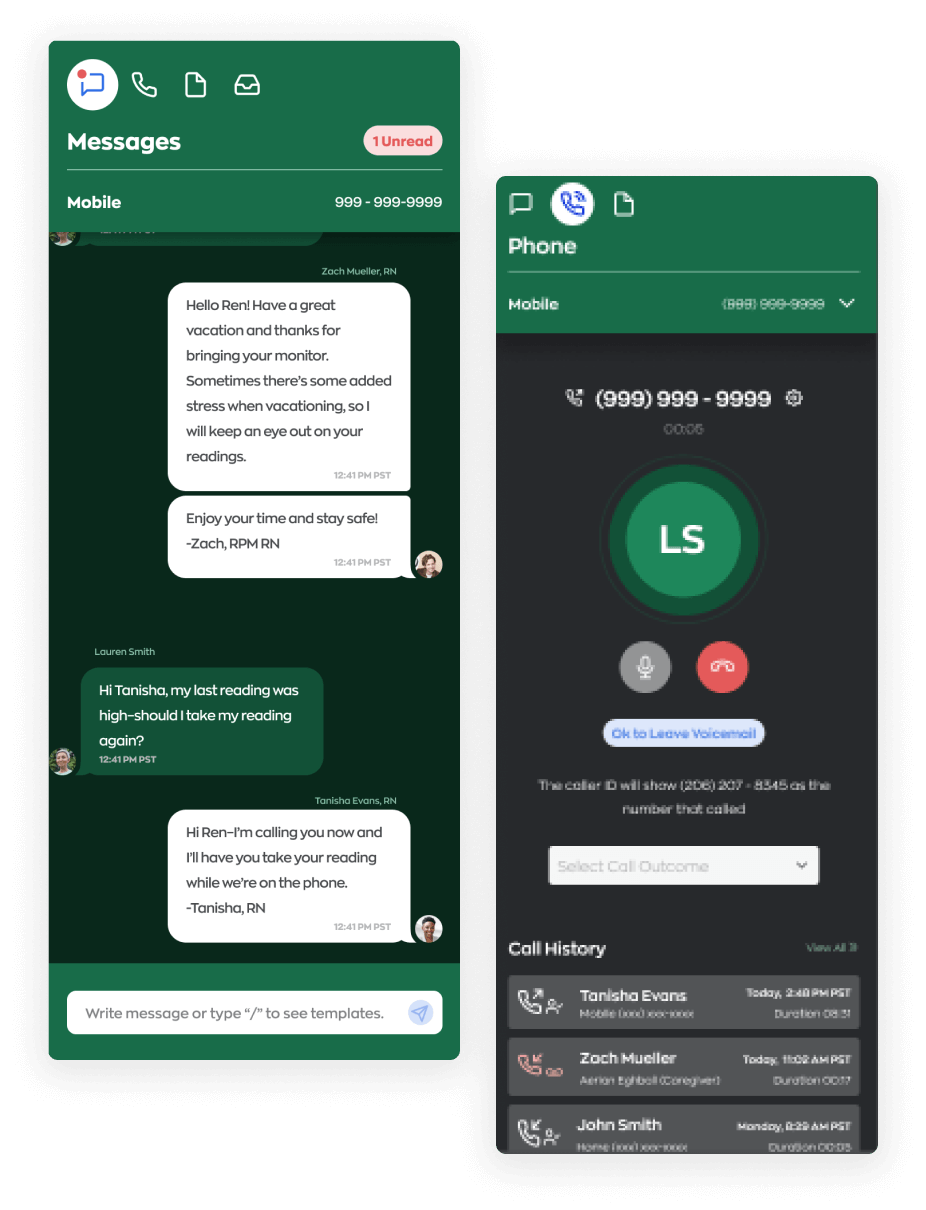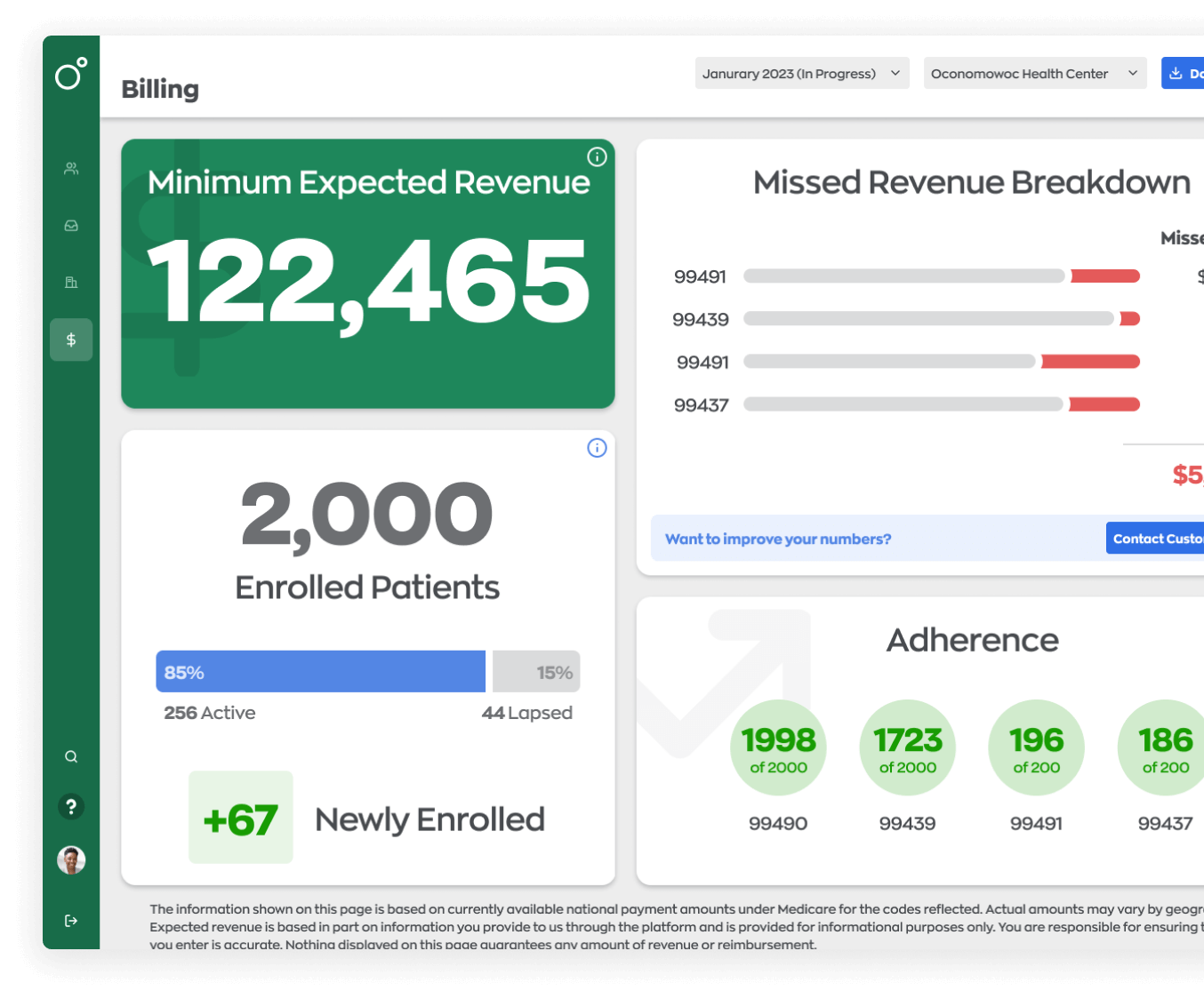
Deliver Better Healthcare Outcomes Starting Today
Optimize Health's remote patient monitoring software gives your healthcare practice the tools it needs to deliver better healthcare outcomes, greater patient engagement, and more revenue per customer. Right now. Today.
Request a Demo
Improved Outcomes, Happier Patients
Optimize Health's remote patient monitoring platform is a simple-to-use system for healthcare providers like yours to provide improved, more modern healthcare. Maximize your time, increase patient engagement, and simplify your ability to monitor and deliver effective treatment plans for a huge range of patients.
Request a Demo
Top-Notch Patient Care Every Day
Optimize Health delivers everything you need to provide the best patient care from one source, to or from any location. Patient health data is sent directly to our secure remote care monitoring platform where you can monitor and analyze it without the need for patient practice visits. Clinical workflows guide you to the best action, every time.
Seamlessly Track Individual Patient Progress
Centralized call history, patient notes and contact preferences supported by global search functionality, enhanced calling features, real-time notifications and message templates make delivering the best patient care a walk in the park.

Total Revenue and Program Potential in One View
Billing Dashboard displays patient billability and expected revenue so you’re not left guessing.
+ Measure program health against total revenue potential
+ Revenue calculated based on total patients enrolled and billing eligibility
+ View patient adherence by CPT code

Benefits Of Remote Patient Monitoring
-
Benefits Of Remote Patient Monitoring
Technological advances in healthcare and remote care programs have positively impacted providers and patients alike. Within the last few years, remote care programs like remote patient monitoring (RPM), chronic care management (CCM), and principal care management (PCM) have been adopted by independent providers and large health systems to improve health outcomes, provide convenient care, and expand patient access to care outside of office visits.
Remote patient monitoring and related remote care programs provide a swathe of benefits that have made a major difference in how healthcare is delivered and the opportunities to provide better care through technology.
Clinical research on remote patient monitoring has shown that it delivers significant cost savings, can increase patient engagement, and add new revenue streams for practices that provide these services.
As one of the leading remote patient monitoring companies, Optimize Health’s clients have seen tremendous real world results. {link to case studies page}. noted that they have seen improved patient and practice outcomes {Iqbal case study} and remote patient monitoring research demonstrates a number of advantages and benefits, including:
- Patients are more involved in their healthcare decisions. This reality increases patient engagement and makes patients more likely to take proactive actions necessary to maintain their health.
- RPM enables medical staff to proactively monitor their patients and check in whenever an issue arises. Instead of waiting for problems to develop, RPM enables medical staff to catch issues before they become too serious to treat without major and expensive medical intervention.
- Physician shortages and medical staff burnout can pose major challenges. RPM keeps patients who don’t need to come in at home, freeing up limited time and enabling medical staff to concentrate on seeing patients who truly need assistance.
-
Advantages and Challenges of Remote Patient Monitoring
The advantages of a patient monitoring system for physicians and patients are clear. When done right, remote patient monitoring can increase revenue and improve patient outcomes.
Specific advantages include:
- RPM can allow physicians easier access to patients and create a culture of increased patient involvement in their care. This increased interaction can improve medication adherence and adherence to an overall patient plan.
- RPM revenue possibilities are extensive. Studies have found that medical practices can generate revenue increases directly from interacting more with patients and providing them with services when they need them.
- RPM can free up valuable time and space for patients who have a clinical need to be seen in office. RPM can be critical in reducing administrative costs.
To be clear, remote patient monitoring challenges unquestionably remain. These include:
- RPM reimbursements are increasing, but some insurance companies may still balk at providing fair and consistent reimbursement for RPM.
- RPM requires a patient to have steady internet access and the appropriate knowledge of technology to operate any medical equipment necessary for successful RPM. Such sophistication may be beyond the capabilities of some patients.
-
Advantages To Physicians of Remote Patient Monitoring
There is no doubt that there are many advantages of patient monitoring systems. Many of these advantages apply specifically to physicians and other medical staff.
Examples include:
- First and foremost, remote patient monitoring allows doctors and medical offices to provide better care and improve outcomes. By checking in with patients before they need help, doctors—aided by appropriate technology and medical dashboards—can ensure that their patients are doing well, adhering to treatment plans, and not needing immediate services.
- Remote patient monitoring challenges can usually be overcome by providing patience with access to world-class experts who understand technological difficulties. These experts should be able to walk patients through any technical problems they may experience.
- Physicians can see an entirely new line of revenue open up as a direct result of remote patient monitoring, which may allow them to provide more and better care with only marginal increases in costs. Some statistics have found that physicians have increased their revenue by as much as 40%.
- Chronic conditions — many of which often interact with each other — are notoriously hard to manage. Remote patient monitoring can allow doctors to better manage concerns surrounding these conditions and provide improved care.
- Remote patient monitoring can dramatically increase productivity. Doctors need to only sit at their computer and examine data, then communicate with a patient efficiently and effectively. This increase in efficiency can ensure that doctors use their limited and valuable time in the most productive and useful methods possible.
As you can see, the benefits of remote patient monitoring are extensive. Doctors, nurses, and other critical medical staff can see major improvements directly from remote patient monitoring.
-
Importance Of Patient Monitoring
Your medical practice needs to be able to answer this critical question: What is remote patient monitoring? It is only by understanding the advantages of a patient monitoring system that you can fully implement such a system and be able to appropriately gauge the importance of such a health monitoring system.
Why are remote patient monitoring systems more important than ever? Consider the following:
- Hospital-acquired infections are a massive problem within the medical industry. By keeping a patient at home and using available technological tools to monitor them and provide care, you can reduce the risk of a patient getting an infection.
- Though slowed, COVID-19 remains a major problem, particularly for a medically vulnerable population. As such, remote patient monitoring allows patients to stay home and avoid potential infection.
- The impact of COVID-19 has remained on our world in more ways than one. Many patients have already become more comfortable getting care remotely. In many cases, they may expect to be able to access telehealth whenever possible, and as such, they may be very open to remote patient monitoring.
-
Why Is Remote Patient Monitoring Important
Remote patient monitoring is unquestionably a real investment of time, effort, and technology. As a result, many physicians and related offices may ask themselves a very fair question: Why is remote patient monitoring important?
The answer is simple: The benefits of remote patient monitoring to both patient care and physicians are extensive. These benefits also extend to numerous branches of remote patient monitoring, including:
- Chronic care management (CCM), in which multiple chronic conditions are monitored via a jointly created patient plan.
- Principle care management (PCM), in which one condition is monitored via remote patient monitoring.
- Remote therapeutic management (RTM), in which patient metrics are monitored for any reason. RTM can be ideal for therapeutic purposes when a doctor or medical staff needs to monitor adherence to a treatment plan.
It is also worth noting that remote patient monitoring wearables—potentially as simple and relatively affordable as a smartwatch—can allow medical staff to monitor a patient’s vitals and gain critical insight into their current medical state.
As noted by the CMS remote patient monitoring fact sheet, doctors and medical staff can make patients more comfortable with RPM in many ways. Examples include:
- Answering all questions about the service
- Creating a written guide to remote patient monitoring
- Explaining how patients can expect their care to improve
Sometimes, the challenges of remote patient monitoring are more on the administrative end than anything else. Remote patient monitoring requires a medical office to engage in an active and continuous effort to better incorporate best practices and ensure their office is ready to manage RPM.
-
How Remote Patient Monitoring Works
No medical office can truly understand the benefits of remote patient monitoring without a solid understanding of this key question: How does remote patient monitoring work?
First, it’s important to understand that the remote patient monitoring business model is not just one device or one example. Indeed, there are entire spectrums of remote patient monitoring best practices that can fit into the broad umbrella of remote patient monitoring.
More to the point, there is an abundance of remote patient monitoring devices and remote patient monitoring software options that can unquestionably show the benefit of this emerging field of medical practice.
Examples of remote patient monitoring include:
- Using wearables to securely communicate critical data, like blood sugar or blood pressure, to a health care practitioner.
- Patients regularly weighing themselves and transmitting that data to medical offices, enabling doctors and other staff to ensure they stay within appropriate weight limits.
- Having patients who are experiencing psychological distress fill out surveys about their mood and thoughts, then checking in with those patients if any problematic behaviors are detected.
Remote patient monitoring statistics make it clear: Monitoring can increase engagement with patients, save patients money, reduce the burden on insurance companies and drive new revenue for practitioners. Yet, even these benefits barely scratch the surface of remote patient monitoring.
There are many potential methods of remote patient monitoring that you can engage in. If you want the best options for remote patient monitoring, contact Optimize Health and learn more about how we can help your medical practice use the latest tools and technology for your remote patient monitoring needs.
Expand your approach to patient care.
